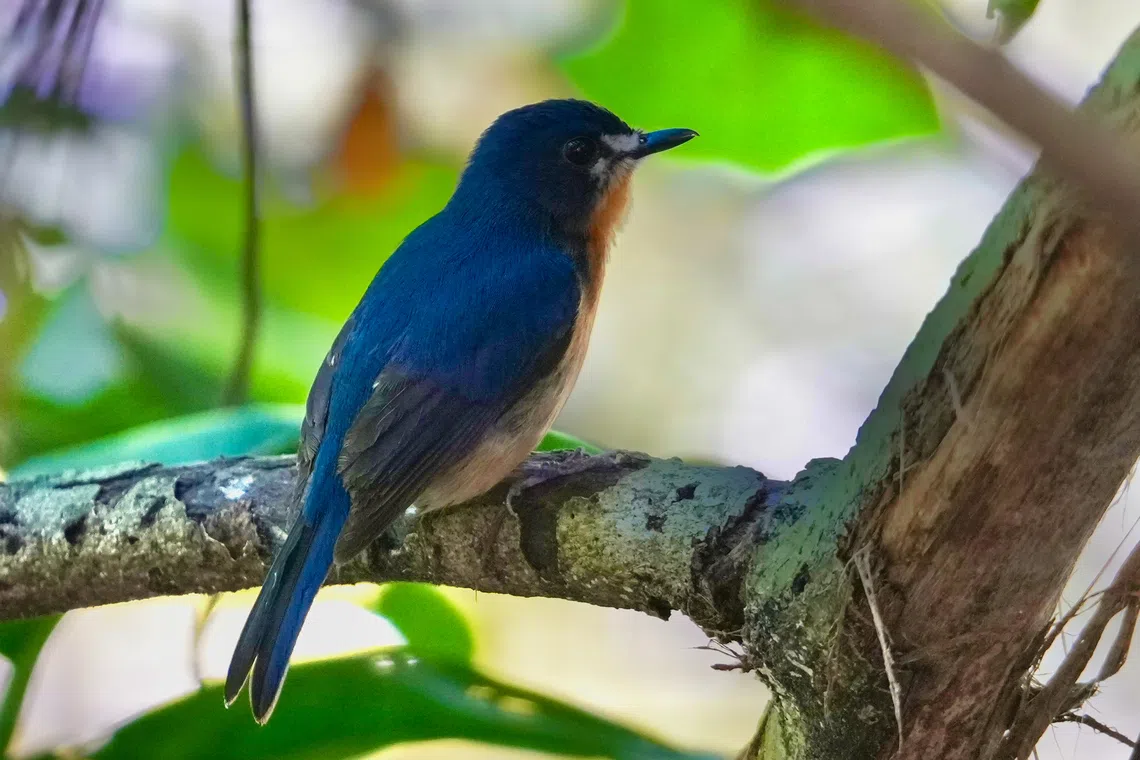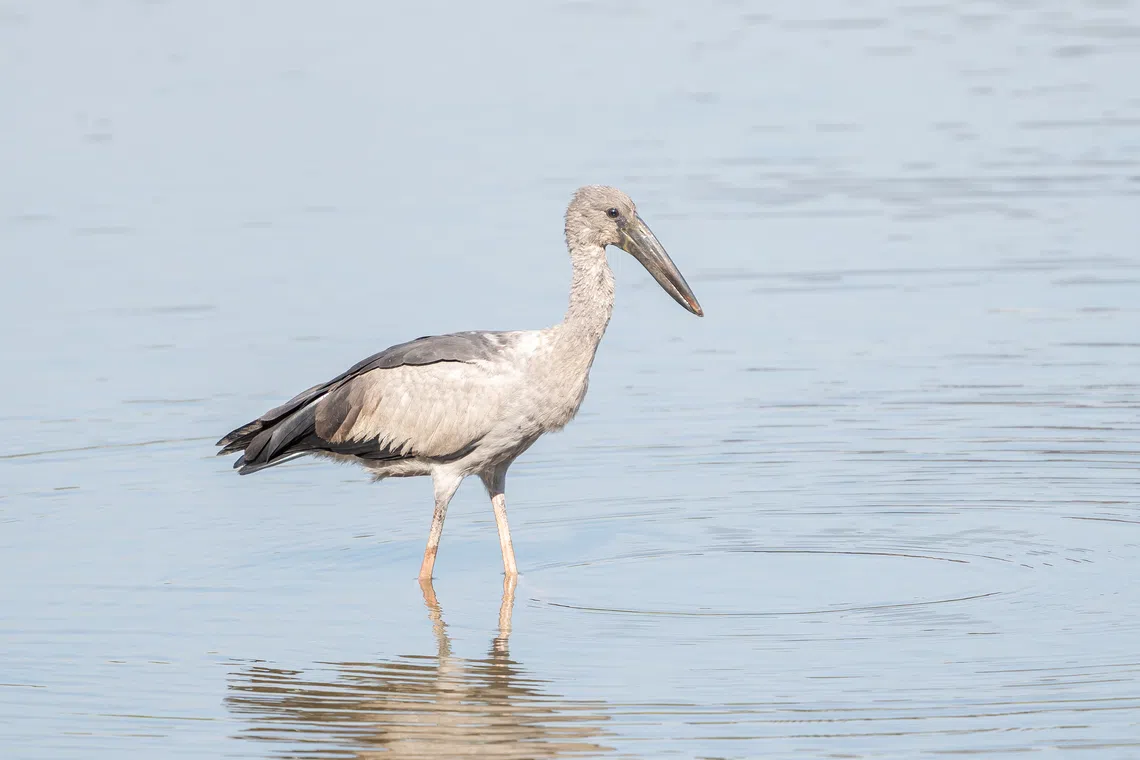Birdwatchers turn citizen scientists on ‘Big Day’ as they log encounters with avian visitors
Sign up now: Get ST's newsletters delivered to your inbox

A mangrove blue flycatcher – a palm-sized bird not often seen in Singapore – spotted near Sungei Api Api in Pasir Ris on Oct 2.
PHOTO: TAN BOON HUI
Follow topic:
SINGAPORE – Some birds may be elusive, but birdwatchers are becoming an increasingly common sight as they trail behind a rare feathery visitor to Singapore.
And they could be seen en masse on Oct 1, a day that witnessed about 20 photographers descending on Pasir Ris to shoot a mangrove blue flycatcher (Cyornis rufigastra), a palm-size bird seen on the Republic’s offshore islands every few years.
Unfortunately, even the best camera in the hands of an enthusiastic birdwatcher failed to capture every fortuitous encounter with a rarely seen bird.
But volunteer-run Bird Society of Singapore (BirdSoc SG) believes that logging these encounters is important, as every observation sketches a picture of how a species is faring.
On Oct 11, the society will organise its inaugural October Big Day, an islandwide event sponsored by Mandai Nature, the conservation arm of Mandai Wildlife Group, to teach Singapore residents how to find birds and contribute their observations to science.
More than 100 participants and BirdSoc SG volunteers are expected to watch out for birds at five locations across the island and then attend an hour of talks at the Singapore Zoo.
BirdSoc SG vice-president Raghav Narayanswamy said: “It gives us an idea of whether there are any trends, for example, if a certain species is declining faster than another.
“This helps us do a better job in targeting conservation efforts.”
The event is held in support of a global initiative of the same name – helmed by global database eBird – that sees participants around the world spending 24 hours logging as many avian species as possible to take stock of bird populations.
In just one day, participants of the May edition of eBird’s Big Day observed an all-time high of about 72 per cent of the world’s bird species.
Such data helps scientists understand migration patterns, population declines and changes in distributions, as well as shape priorities of how ecosystems should be managed.
Citizen science leverages public participation to help monitor birds where researchers cannot.
The mangrove blue flycatcher in Pasir Ris, for instance, was first flagged by a member of the public on Sept 30.
As many birds migrate hundreds of kilometres to escape the winter chill, tracking them is often a difficult and costly endeavour.
Located at the intersection of two major migratory routes for birds, Singapore is a pit stop for them to rest and refuel between August and March, making the Republic a prime location to monitor migratory birds.
Avian ecologist David Tan said: “Singapore may be small, but because this project is global in nature and occurring across multiple years, participants in Singapore will be joining thousands of other citizen scientists from around the world to record bird observations, allowing scientists to paint a global picture of bird occurrences across space and time.”
Currently, eBird has helped document the migratory bird patterns and trends in Singapore, said Mr Narayanswamy, who also leads BirdSoc SG’s web-based projects, including the Singapore Bird Database.
The NTU computer science student cited the Asian openbill (Anastomus oscitans), a stork that stands up to 81cm tall, which incrementally became a regular sight in Singapore
“Their rapid spread has possibly been aided due to the increasing numbers of the invasive golden apple snails present across South-east Asia – these snails are now a key part of the openbills’ diet,” he said.
“Their biggest influx into Singapore was in 2019, when 5,000 birds were recorded on one day.”

The Asian openbill (Anastomus oscitans) has incrementally become a regular sight in Singapore after it was first recorded here in 2013.
PHOTO: JARED TAN
Critical to these insights is good record-keeping, which Mr Narayanswamy hopes the BirdSoc SG’s Big Day event will promote.
“While allowing anyone to submit their findings to eBird is good, as it can collect a large amount of information, it’s important to moderate these sightings to maintain eBird as a high-quality collection of data,” he added.
There have been reports of migratory birds during the summer months when most migratory species are not expected to be seen, so these require more careful review, he noted.
The event will be the biggest organised by the society, and the first to mark its partnership with eBird that began in October.
It comes as a rising number of enthusiasts in Singapore log their bird sightings for science.
Dr Tan, a postdoctoral research fellow at the German Centre for Integrative Biodiversity Research, said there is a high uptake of the eBird database in Singapore.
This means there is a good chance that citizen scientists will be able to collectively generate high-quality data for understanding where and when bird species occur in the region, he noted.
BirdSoc SG’s effort joins several long-running bird-focused projects in tapping public participation, including bird censuses by Nature Society Singapore and the NUS’ Lee Kong Chian Natural History Museum’s project that collects bird carcasses from the masses.
Said Dr Tan: “(Surveys by the Nature Society Singapore) have been critical for identifying significant changes in bird populations in Singapore over time, such as the critical decline of migratory shorebirds and the gradual recovery of the oriental magpie robin in Singapore over the last few decades.”
Correction note: This story has been edited for clarity.


